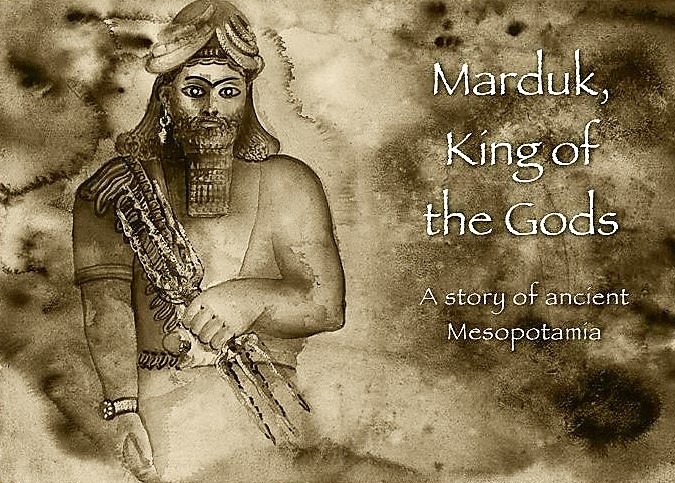Scholars, archaeologists, historians and theologians have suggested 50 names or titles for Marduk none on which is correct. Scores more are still trying to reconstruct the famous name and the author of Babylonian Prayers to Marduk is not sure about the origin of the name or the identity of its holder.
How can that be, guys?
Just read his name carefully and consult Lisan al-Arab for the rest.
Will it make a difference to all those concerned if it is ¬¬_Mu_rduk, as in A_mu_rru, not Marduk?
Several important translations of the Code of Hammurabi exist and interpretations and commentaries on various aspects of the Code are countless. Some writers provided background to the Code but many are waiting for more information to understand the historical, social and religious contexts of the Code and what possible reasons prompted Hammurabi to compile the laws and distribute copies in his land.
Work is still needed to shed better light on the man and his time so it is important to know when he was declared king. Earlier historians assigned 2342 BC as the year of his accession. Others have suggested his reign was between 2130-2088 BC, 2121-2066 BC or 1990- 1950 BC. More recent suggestions indicate to 1810 BC as his birth date, 1750 BC for his death and 1792-1750 BC for his reign of 42 years.
Clearly there seems to be a problem here. Can’t any of the contemporary stelae of the Code be carbon dated or is this a silly question? If he died in 1750 it means he lived for 60 years. His term was for 42 years so he became king when he was 18 years old. The year 2342 was specified in earlier suggestions as the year of his accession meaning he was born in 2360 BC. The difference between this date and the more recent suggestion of his birth in 1810 is 550 years.
http://en.wikipedia.org/wiki/Hammurabi
There’s something wrong here. Certain concepts in the Code were used in religious books. Religions are built usually on belief. Belief is not dependent on history. However, certain stories in religious books determine time, and therefore appear to provide a dated history.
This is risky and potentially backfiring business.
In cases were certain tablets or artefacts are carbon-dated, conflict may arise and discrepancies emerge. The historicity of the Bible is the question of its “acceptability as a history,” in the phrase of Thomas L. Thompson, a scholar who has written widely on this topic as it relates to the Old Testament” Thompson, Thomas L. (2014). Biblical Narrative and Palestine’s History: Changing Perspectives 2. Routledge, p. 164).
But see here:
http://en.wikipedia.org/wiki/Historicity_of_the_Bible#cite_note-FOOTNOTEThompson2014164-1
It is mostly commonstream literature so Wikipedia is as good as any:
The oldest surviving Hebrew Bible manuscripts – including the Dead Sea Scrolls – date to about the 2nd century BCE (fragmentary) and some are stored at the Shrine of the Book in Jerusalem. The oldest extant complete text survives in a Greek translation called the Septuagint, dating to the 4th century CE (Codex Sinaiticus). The oldest extant manuscripts of the vocalized Masoretic Text (the basis of modern editions), date to the 9th century CE.[1] With the exception of a few biblical sections in the Prophets, virtually no biblical text is contemporaneous with the events it describes.[2]
http://en.wikipedia.org/wiki/Dating_the_Bible
Still not close enough to Hammurabi’s time and Code but much closer. Hammurabi, then, appears to be first and probably it is time to give up, return to belief and leave historicity to real, provable history.

Marduk and pet
From an earlier article we learn that Babylonia in Hammurabi’s time was under a condition of vassalage to neighbouring Elam. A decade or more into his reign he defeated the king of Elam and freed Babylonia. Successive victories gave him the chance to claim the title of king of Sumeria and Akkad. “Towards the end of his life he had knit together into a mighty empire of north and south Babylonia, and very likely extended his sway, at least nominally, over the land of Amurru as far as Canaan.”
http://newadvent.org/cathen/07125a.htm
The word Akkad in the text is problematic but that’s for later.
It was said earlier that Hammurabi’s full title is H “this is”, ammur “aMur”, ab “father”, i “my” = _Ammur is my father_. Surely if Hammurabi’s very title carries the name of Ammur all the clans of the tribe of Ammur (Amorites) will under his command of his faithful allies.
The proper noun Ammur is derived from an organic linguistic origin*MR. The code of Ancient Arabian, or “Proto-Semitic” in commonstream literature, is made of some 450 two-letter roots. These roots are used for all types of communicative and identification needs including, verbs, nouns, propositions, articles and proper nouns. If the word is Ancient Arabian it should have a bilateral root.
In prehistoric times ancient Arabians appear to have been alone in southern Arabia. They were joined later by groups from a different race, the Sum who appear to have had their home in the highlands of Ethiopia. Their language was different from Ancient Arabian. Around 4,000 years ago they adopted the language of ancient Arabians so the best examples of the former language are found in Sumerian.
The Sum are a distinguished race. Alone or in collaboration with a distinguished clan of the tribe or A’ad, Jad then Jaees, they appear to have initiated the Agrarian Era and produced our famous alphabet known in commonstream literature as “Phoenician”.
From their name root, *SM (SUM), words still in use in Arabia today include dark colour (asmar), nail (musmar), entertainment (samar) and by extension musical instruments necessary for entertainment, and probably fertilizer (samad) which could be also from the root *MD “to extend something”.
Factions of the Sum became historical allies of one of the two only tribes in ancient Arabia, the Adites. The leader of the Adites is Ad or Adad or Hadad or Adonai or Adapa. Ad or Adad had four sons each with his own clan:
1- Tay (Ṭay) leader of the most famous Tay tribe. He is also known as Jalham, but probably Galham, from the Nucleitic Compound *GL/*HM, but please note another Nucleitic Compound famous name *PR/*HM, Abraham,
2- Nabt, the founder or the tribe of Ashar, but probably the Nabataens as well,
3- Malik, the founder of the tribes of Qahtan,
4- Mur or Murrah, the founder of the tribes of Jazam, Lakham and Kindah.
Clearly these are some of the most famous tribes in Arabia and the most numerous.
These four names as well as most names are derived from bilateral roots. In the case of Mur it is *MR. Explained earlier that the root *MR is well know and widely used in Arabic to mean “bitter”. This root is a category, a linguistic container, of types of food eaten or avoided during famines, a recurring event during winter in the ancient world, as well as bitter medicine to cure indigestion or food poisoning.
There’s an ancient tradition in ancient Arabia of choosing names for boys and girls. Girls are named to please their parents and tribe so “cute” names are usually chosen like ‘Farah’ “happiness”, ‘Qamar’ “moon”, ‘Hanan’ “tenderness”, etc. Boys are named to ward off enemies, so “serious” names are chosen for boys. Names such as ‘Assad’ “lion”, ‘Nimre’ ‘tiger”, ‘Saba’ “a general name for all wild cats”, ‘Dhaba “hyena”, Kalab’ “dog”, ‘Zeeb’ “wolf”, ‘Saif’ “sword”, and the like.
The proper noun Mur does mean bitter but bitterness is widely used metaphorically, as in “bitter enemy”. The same applies to Arabian and later to Arabic.
In Yemen today a speaker can say, “Murh”, meaning “order him”. However most other speakers of Arabic would say, “Amurh” to mean exactly the same. The noun from the name root is ‘amar’ “order”. The name of the tribe founded by MR is ‘Amorite’ (ammoryyin), after his name.
It simply means “the tribesmen of Mur” because his tribe became so numerous even clans from his tribes became huge tribes like Jazam, Lakham and Kindah, hence the reference to the 12 kings who live in tents in Mesopotamia but God is also said by Canaanite to live in a huge tent.
Collectively, all these tribes have one founder Mur. Derivatives from the natural root are many and easy to formulate. However, Mur as a proper noun cannot be treated as the natural root. The Yemenis do use “Murh”; to mean “order him” but the root here has nothing to do with the natural meaning of bitter taste but all to do with the man who can give orders to everybody in the tribes under his tribal leadership.
His ‘orders’ were ‘awamer’, plural. The singular is ‘amre’ “order”. The derivative ‘ammar’ means somebody who has the authority to give orders. MR’s wife may call him ‘Mur, hun bun”, like John’s wife would call her husband. If John were king he wouldn’t be called John by most other people.
Primary Applied Etymology can’t exclude the possibility that Hammurabi was the blood son of Mur but then he wouldn’t call him ‘Ammur’ but ‘Mur’ like “Mur, or John, is my dad.” Tribal systems are laws in the sense the head of the tribe wouldn’t normally appoint an outsider for a vital position like a king. It is more likely than not that Hammurabi was head of one of the clans of the tribe of Mur. This may explain the fact that he was able to appoint his son as successor to the throne without reported objection.
The god Marduk has been assigned fifty different names none of which is his real name, Mur. Clearly, the throned descendents of Mur chose their granddad to be god. The legitimacy is solid because it is both hereditary and religiously.
No matter how big an Ancient Arabian word is, the key to identify its origin is to identify the root or, in the case of Nucleitic Compounds, the two roots that make this unique linguistic structure. For example, the Arabic word ‘mouaamaraat’ “conspiracies” is rooted in *MR, the proper noun: mouaaMaRaat. ‘Omaraa’ “princes” is the same, letter 2 and 4. ‘Amarrah’ “emirate” likewise.
The words derived from the name of the man Mur are critical in a language like Arabic. These words must be separated from extensions derived from the natural root that means bitterness. They are from Mur the great leader and the great god of Mesopotamia.
Now, what is the difference between Mur and Mar?
The majority of Ancient Arabian roots are open for the first letter and silent for the second, i.e. ‘a’ for the first and un-vowelised for the second. In cases where natural roots are used for proper nouns, the vocalisation in some cases is changed to ‘u’. For example, *DM (dam) is “blood”. The species of Neanderthals, according to preliminary etymology, are called DUM “the short & ugly”. The root of the famous south Arabian Prophet Hud is *HD. Why ‘u’ not ‘a’? Because *HD is also a natural root with an original meaning of “to destroy”.
From the proper noun *MR is ‘amara’ “emirate”. People use this word but also “imarah”. This applies to the natural root. ‘Mur’ is “bitter” but one can say “marara”. The Arab mind compensates for these slight differences but Europeans have a problem understanding some rules of Ancien Arabian because vowels are essential letters in a word or a name but Arabians and Arabs use most vowels to facilitate speaking. The mind identifies the consonantal roots. This is why roots that include a vowel are an absolute headache for lexicographers. To avoid this huge problem, some went as far as trying to re-order their dictionaries on the basis of the last letter of words.
Not a rule but if the root has a vowel it is probably an Adite invention. The hamza for them is the ‘click’ of the African ancient language.
Mur is not a secret and those who advised historians to leave the Arabic linguistic bread to those who know how bake it best advised well. Had historians consulted a dictionary like Lisn Al Arab they could have saved themselves months of unnecessary work.
The entry in Lisan Al Arab is not Mur but Mar. Ad himself and his children were incessantly chased by A’adites their very name became a natural root that means “to cross, to go and to keep going”. Mar in the dictionary is a huge entry with more than 3,000 words of explanation.
Towards the end you will find this: “Mur is the father of Tamim and the son of UD”. Ud is Ad, Adad, etc.
Last modified: June 1, 2023



